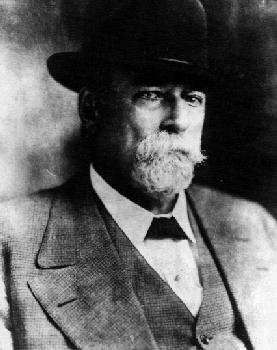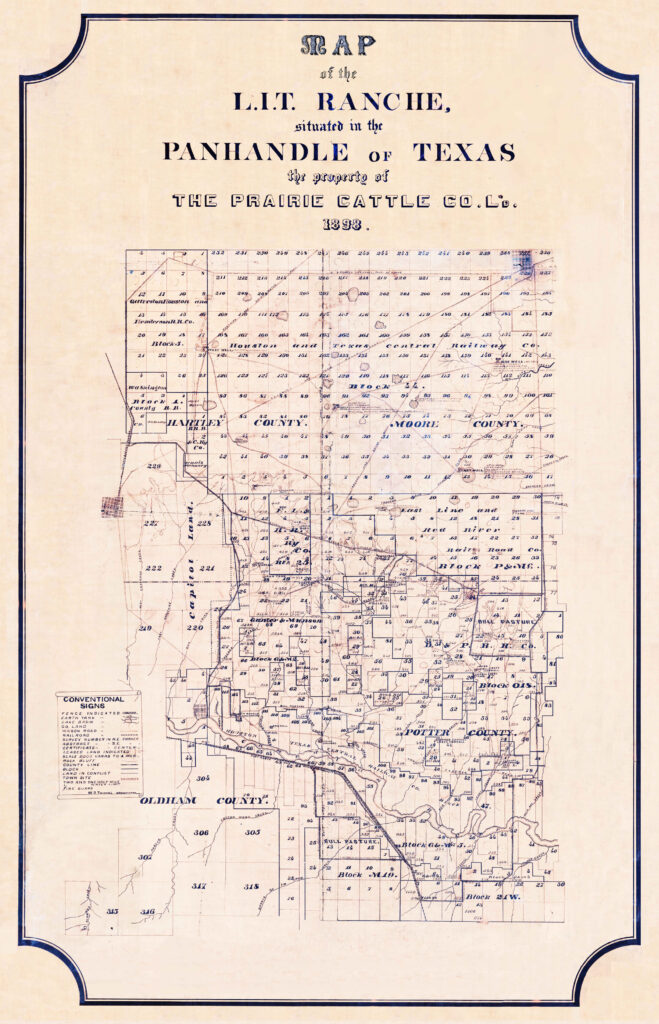
Major George W. Littlefield
The LIT Ranch namesake deserved attention not only for creating the 240,000 acre spread that became the LIT Ranch, but more importantly for forging the occupation known then and now as “cow trader”. Major Littlefield discovered that he could aggregate large herds of cattle in South Texas and trail drive them to Dodge City, Kansas where he could almost double his money on the herd. In the 1870s, the Major would buy as many as 10,000 cattle at prices ranging from $8-10 head and then hire a crew to drive them north. In Dodge and elsewhere he was able to sell the stock for $20-25 per head. It cost him $1.50 per head to herd the cattle to Kansas. Major Littlefield was more sophisticated in his trading than most dealers and he would frequently forward contract the cattle for future delivery instead of taking a market risk. His competitors often went broke speculating on the markets.
LIT RANCH
The LIT Ranch started when George W. Littlefield sent a herd of mixed cattle to Dodge City from Central and East Texas in the summer of 1877. He and his associates found that the abundance of cattle from many outfits resulted in extremely low prices in Dodge City. Rather than sell at a loss, he sought a suitable open range to winter his herd and sent two employees, Charles S. McCarty and John Hollicott, to scout out the Texas Panhandle. McCarty and Hollicott reported excellent grass along the Canadian River in the vicinity of the new settlement of Tascosa, in what is now Oldham County. Thus, in the fall of 1877 J. Phelps White, who served as the outfit’s trail boss, brought 3,500 cattle to the Panhandle. When spring failed to bring higher cattle prices the owners decided to establish a squatter ranch on this free river acreage, where bluffs, canyons, and trees afforded them protection. The range extended approximately twenty-five miles along the Canadian River between Cheyenne and John Ray creeks and covered the breaks on both sides of the river for about fifteen miles. The brand was taken from Littlefield’s name, with the L on the left shoulder of the animal, the I on the side, and the T on the hip. The LIT established a temporary dugout headquarters on Pescado Creek three miles west of Tascosa. They soon found a more suitable site with five springs, four miles east of town. This location was occupied by Henry Kimball, the town blacksmith, who had followed Casimero Romero to the area several months earlier. After purchasing the site from Kimball, the LIT men constructed a substantial stone and adobe ranchhouse, along with stables, corrals, and branding pens. Charles McCarty, one of Littlefield’s most reliable men, took charge of the ranch and hired Bud Wilkerson, Bob Robinson, and Dudley Pannell as wagon bosses. Gene Watkins and Harry Ingerton were also outstanding LIT cowboys. Billy the Kid (alias Henry McCarty, Billy Bonney, Kid Antrim) and his gang traded some stolen horses to the LIT in 1878.

Although the Littlefield men never obtained a legitimate claim to their holdings, they added to them small herds and tracts bought from neighboring ranchers who had also squatted in the area. Eventually their range, which featured stretches of free grassland, grew to around 1,000 square miles. The LIT men played a leading role in the organization of Oldham County in 1880. On the night of the county’s first election Dudley Pannell and another cowboy named Phillips stayed late in Tascosa to get the returns. While riding back to the ranch the two men began shooting into the air in a spirit of celebration. Pannell’s horse suddenly shied and jumped when a careless shot from Phillips’s pistol grazed Pannell’s head and knocked him off his mount. The terrified horse then dragged him to death when his foot hung in the stirrup. Pannell was buried on a knoll near the LIT headquarters. July 1881 the Prairie Cattle Company offered to buy Littlefield’s herds and improvements. Though he was at first reluctant to sell, Littlefield soon changed his mind when the British syndicate offered him $253,000 for his 14,000 head of cattle, 250 saddle horses, and headquarters buildings. He subsequently began his LFD operation in New Mexico. Although many LIT men, including Charles McCarty, followed Littlefield there, others like Gene Watkins chose to stay in the Panhandle. On March 24, 1884, Watkins and a Mexican named Julián Martínez shot and killed each other in a confrontation over a monte game in a Tascosa saloon. Dave Martínez, Julián’s brother, was also killed in the resulting melee. The Martínez brothers were consigned to Boot Hill, while Watkins was buried on the knoll beside Dudley Parnell. The Prairie Cattle Company made the LIT buildings a division headquarters and continued using the brand on that range. The first division manager, Gus Johnson, was killed by lightning while riding the range. Under his successor, Willard R. Green, a stockholders’ dividend of 20.5 percent was declared, causing ecstasy among the company’s Scottish investors. Mack Stewart, H. F. (Frank) Mitchell, Ed Paine, and Joe Frazier served successively as range managers on the LIT between 1884 and 1913. In the latter year the Prairie Cattle Company sold its LIT holdings to Lee Bivins, who had earlier bought a portion of the neighboring LX Ranch. This acquisition made Bivins the world’s biggest single ranch owner, especially after the abandoned Tascosa townsite became a part of the LIT. After Bivins died in 1929 the LIT fell to his sons, Miles and Julian. Julian remodeled the original Oldham County Courthouse as a country home for his family and, in 1939, gave the old Tascosa site for Cal Farley’s Boys Ranch. After Julian’s death in 1940 the LIT was owned and operated by his son, Oliver Bivins. In 1984 the ranch was purchased by the Texas Beef Group, a ranching, farming and cattle feeding company, managed and owned in part by W. H. O’Brien of Amarillo. Mr. O’Brien purchased the interests of the other partners in 1996 and owns the ranch today with his family. Cottonwood saplings planted by Henry Kimball in 1876 now tower above the old headquarters on the Canadian River ten miles south of Channing,Texas.